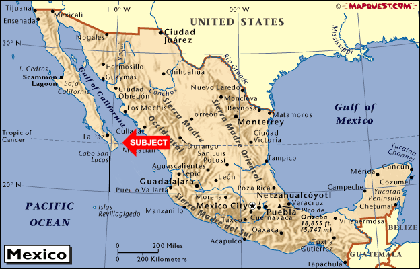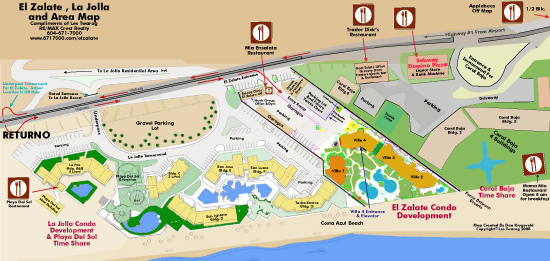|


Click Above Map For Large
View
Click
Here To Print Above Map
Update Tourist Corridor map link


Click
Here For Large View Click
Here To Print Above Picture
 When Baja was torn from the Mexican mainland, and the San Andreas
Fault opened like a zipper, nature set Baja aside as something
special. It must have been a spectacular event. No one is sure
when the first Indians arrived in Baja. At least 12000 years
ago perhaps earlier the most significant human migration occurred
when the ancestors of American Indians crossed from Siberia
to Alaska via a land bridge across the Berring Straight. At
least 10000 years ago, according to radiocarbon dating of artifacts
like stone tools and arrowheads; descendants of these immigrants
reached the Baja peninsula by way of mainland California. There
were four tribes in Baja Sur and the Pericu inhabited Los Cabos.
They did not wear clothes. They didn't build houses or tents
they lived off of the land (ate mostly fruit of the Cactus)
and when it was cold, dug a tiny hole, and everybody crawled
in to keep warm. A man's wealth was determined by how many wives
he had. Makes sense, they had to forage to eat. The more wives
you had out hunting for food, the less likely you were to get
hungry. Some anthropologists say the Pericu descended from the
Pacific Indians.. .and closely resemble a unique tribe found
in South America...but its all speculation. Of course they're
all gone now. One reason, the missionaries tried to establish
communes where the Indians would live. The confinement was something
the Indians couldn't take. They said they had to see the stars
or they would die. From the first Baja has been populated by
dreamers. Even the name California is out of the imagination
of a popular C~lll'iaMiill""aaeeeeee Esplandian (The
Exploits of Esplandian) published in Sevilla by Garci Ordonez
de Montalvo who wrote of a magical land... peopled by beautiful
black amazons who carried gold spears and armor. That was in
1510 and when the first Europeans landed in Baja 20 years later
they thought that this must be the California the author was
talking about.
When Baja was torn from the Mexican mainland, and the San Andreas
Fault opened like a zipper, nature set Baja aside as something
special. It must have been a spectacular event. No one is sure
when the first Indians arrived in Baja. At least 12000 years
ago perhaps earlier the most significant human migration occurred
when the ancestors of American Indians crossed from Siberia
to Alaska via a land bridge across the Berring Straight. At
least 10000 years ago, according to radiocarbon dating of artifacts
like stone tools and arrowheads; descendants of these immigrants
reached the Baja peninsula by way of mainland California. There
were four tribes in Baja Sur and the Pericu inhabited Los Cabos.
They did not wear clothes. They didn't build houses or tents
they lived off of the land (ate mostly fruit of the Cactus)
and when it was cold, dug a tiny hole, and everybody crawled
in to keep warm. A man's wealth was determined by how many wives
he had. Makes sense, they had to forage to eat. The more wives
you had out hunting for food, the less likely you were to get
hungry. Some anthropologists say the Pericu descended from the
Pacific Indians.. .and closely resemble a unique tribe found
in South America...but its all speculation. Of course they're
all gone now. One reason, the missionaries tried to establish
communes where the Indians would live. The confinement was something
the Indians couldn't take. They said they had to see the stars
or they would die. From the first Baja has been populated by
dreamers. Even the name California is out of the imagination
of a popular C~lll'iaMiill""aaeeeeee Esplandian (The
Exploits of Esplandian) published in Sevilla by Garci Ordonez
de Montalvo who wrote of a magical land... peopled by beautiful
black amazons who carried gold spears and armor. That was in
1510 and when the first Europeans landed in Baja 20 years later
they thought that this must be the California the author was
talking about.
The discovery was pretty violent. After defeating the
Aztecs and occupying most of central Mexico, Hernan
Cortez dispatched several expeditions in search of rich
lands as described in the book of Montalvo. In 1532 two
ships sailed north from Acapuico, but both ships
disappeared shortly after departure. In 1533 the
A Little Bit of Baja History
Concepcion sailed in search of the ships but soon after
leaving Acapuico, Pilot Fortun Ximenez led a band of
mutineers, who killed their captain in his sleep and
headed for La Paz. There they found the famous black
pearls and the attractive Indian women. Husbands took
exception to the attention paid to their wives, so they
killed Ximenez, and only a few of the mutineers escaped
back to the mainland. But with them came tales of the
fabulous black pearls.
World politics now plays a part in the Baja history. Queen
Elizabeth took the throne. Spain and England started
taking swipes at each other. And the Queen gives
privateers the right to go out and capture Spanish ships.
About this time the famous Spanish galleon route from
Manila to Acapuico was established.
By the time the ships made the crossing the crew was
sick and dying of scurvy. So they decided (it's more
complicated than that) to pull into Baja. The only fresh
water was at San Jose (the river still flows, and is the
source of the estuary that is home to over 200 different
species of birds) Somehow the word got back to England
and the Sea of Cortez became a hunting ground for
galleons. Sort of like the whalers who would show up in
a century or two.
Along comes sir Francis Drake who begins a career of
piracy that would ultimately be called the "scourge of
God" by its Spanish victims, and opens up the Pacific
to
British privateers and pirates. He briefly touched the tip
of the peninsula to take on the water and then proceeded
north. The galleon route from Manila to Acapuico was
along the Japanese current. The trip took about six
months. Baja Sur's history is filled with famous battles
and adventures as the pirates played their game for
almost 350 years. In 1700 it was a Jesuit Missionary Padre
Kino, stationed at Mission Dolores in Sonora, in an
attempt to discover a land route to supply the
unreplenished Mission at Loreto, explored to the North
and confirmed that California was not an island but a
peninsula. The padres were brave, undiscouraged by the
wild surroundings, and their accomplishments were
extraordinary. They charted and explored the east and
west oast of the peninsula. The mission fathers taught
the Indians to cultivate the land. Grapes were grown and
wine pressed to be exchanged for goods from Mexico.
The Jesuits were responsible for the planting of the first
crops in Mulege in their mission founded in 1705.
In San Jose del Cabo things weren't going to well for the
missionaries. In 1734-37 the Pericus, fed up with the
missionary style of life, hashed the head of the padre
Nicolas Tamaral who founded the mission in San Jose
The ordeal of Father Tamaral in the hands of the natives
is depicted in a mosaic on the facade of the church in San
Jose's town square. The missionaries, on their way out
of town had left their revenge. From 1742-44 epidemics
of smallpox, measles and syphilis (souvenirs left behind
by the pirates and privateers) virtually wiped out the
remaining Pericu. To get a glimpse of what remains from
the Pericu, spectacular petroglyphs and cave paintings
dot the peninsula. Some are abstract designs while
others are representations of humans and animals.
Nomadas Adventure tours offers non-strenuous day trips
to see cave paintings in the mountains.


Click
above picture for large view
Click
Map below to enlarge
Click Here to Get Printable Map

Click
Here For Large Version of Cabo San Lucas Street Map
|